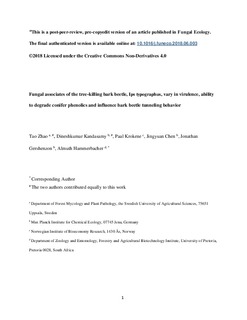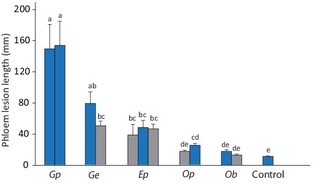| dc.contributor.author | Zhao, Tao | |
| dc.contributor.author | Kandasamy, Dineshkumar | |
| dc.contributor.author | Krokene, Paal | |
| dc.contributor.author | Chen, Jingyuan | |
| dc.contributor.author | Gershenzon, Jonathan | |
| dc.contributor.author | Hammerbacher, Almuth | |
| dc.date.accessioned | 2019-04-08T10:42:29Z | |
| dc.date.available | 2019-04-08T10:42:29Z | |
| dc.date.created | 2019-01-17T12:48:12Z | |
| dc.date.issued | 2018-07-20 | |
| dc.identifier.citation | Fungal ecology. 2018, . | nb_NO |
| dc.identifier.issn | 1754-5048 | |
| dc.identifier.uri | http://hdl.handle.net/11250/2593679 | |
| dc.description.abstract | The bark beetle Ips typographus carries numerous fungi that could be assisting the beetle in colonizing live Norway spruce (Picea abies) trees. Phenolic defenses in spruce phloem are degraded by the beetle's major tree-killing fungus Endoconidiophora polonica, but it is unknown if other beetle associates can also catabolize these compounds. We compared the ability of five fungi commonly associated with I. typographus to degrade phenolic compounds in Norway spruce phloem. Grosmannia penicillata and Grosmannia europhioides were able to degrade stilbenes and flavonoids faster than E. polonica and grow on minimal growth medium with spruce bark constituents as the only nutrients. Furthermore, beetles avoided medium amended with phenolics but marginally preferred medium colonized by fungi. Taken together our results show that different bark beetle-associated fungi have complementary roles in degrading host metabolites and thus might improve this insect's persistence in well defended host tissues. | nb_NO |
| dc.language.iso | eng | nb_NO |
| dc.rights | Navngivelse 4.0 Internasjonal | * |
| dc.rights.uri | http://creativecommons.org/licenses/by/4.0/deed.no | * |
| dc.subject | Ips typographus | nb_NO |
| dc.subject | Fungal symbionts | nb_NO |
| dc.subject | Endoconidiophora | nb_NO |
| dc.subject | Grosmannia | nb_NO |
| dc.subject | Ophiostoma | nb_NO |
| dc.subject | Phenolic defenses | nb_NO |
| dc.subject | Detoxification | nb_NO |
| dc.subject | Complementary roles | nb_NO |
| dc.title | Fungal associates of the tree-killing bark beetle, Ips typographus, vary in virulence, ability to degrade conifer phenolics and influence bark beetle tunneling behavior | nb_NO |
| dc.type | Journal article | nb_NO |
| dc.type | Peer reviewed | nb_NO |
| dc.description.version | acceptedVersion | nb_NO |
| dc.rights.holder | © 2018 Elsevier Ltd and British Mycological Society. All rights reserved. | nb_NO |
| dc.subject.nsi | VDP::Landbruks- og Fiskerifag: 900::Landbruksfag: 910::Skogbruk: 915 | nb_NO |
| dc.subject.nsi | VDP::Landbruks- og Fiskerifag: 900 | nb_NO |
| dc.source.pagenumber | 9 | nb_NO |
| dc.source.journal | Fungal ecology | nb_NO |
| dc.identifier.doi | 10.1016/j.funeco.2018.06.003 | |
| dc.identifier.cristin | 1659274 | |
| dc.relation.project | Andre: HA7617/1-1 | nb_NO |
| dc.relation.project | Norges forskningsråd: 221479 | nb_NO |
| dc.relation.project | Andre: 229-2011-890 | nb_NO |
| cristin.ispublished | true | |
| cristin.fulltext | postprint | |
| cristin.qualitycode | 1 | |


